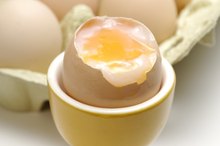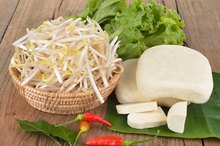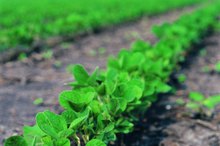Candida Diet & Soy
The candida diet aims to reduce the amount of yeast -- and nutrients that “feed” yeast -- in the foods that you eat. Candida refers to Candida albicans, the fungus that causes vaginal yeast infections. Some people have a condition called chronic candidiasis or yeast hypersensitivity syndrome, which involves an overgrowth of candida in the gastrointestinal tract. Soy doesn’t appear to aggravate or help candidiasis. Consult your doctor before beginning a candida diet.
If you are experiencing serious medical symptoms, seek emergency treatment immediately.
Avoid
The candida diet excludes foods that contain yeast or mold, such as:
- cheeses
- dried fruits
- alcohol
- peanuts
- according to the University of Michigan Health System
Mushrooms, breads made with baker’s yeast, tomato paste and beer are all eliminated as well, notes the University of Pittsburgh Medical Center 1. The diet also eliminates or limits the amount of foods you eat that contain sugar and milk, such as sweets and dairy products, because these nutrients are thought to “feed” yeast and promote its growth.
Considerations
Yeast, Gluten and Dairy Free Diets
Learn More
Soy isn’t listed among the foods that either contain yeast or “feed” yeast. But certain types of soy products could fall into one of the two categories. For example, fermented tofu or soy products that contain sugars for flavoring would be banned under the candida diet. Additionally, keep in mind that adding certain foods such as yogurts containing probiotic cultures and fish or nuts that are rich in omega-3 fatty acids could actually help in treating candidiasis, according to the University of Maryland Medical Center 1. Certain spices such as:
- oregano
- cloves
- sage
- garlic
- cinnamon may offer antifungal actions
- while whole grains are a rich source of B-complex vitamins
- Soy isn’t listed among the foods that either contain yeast or “feed” yeast.
- For example, fermented tofu or soy products that contain sugars for flavoring would be banned under the candida diet.
Key Nutrients
Certain dietary supplements could help to support a candida diet as well. Caprylic acid and bee propolis may also offer antifungal actions. Digestive supplements such as betaine hydrochloric acid and pancreatic enzymes could help prevent candida from penetrating the small intestine, says the University of Michigan Health System. Talk with your physician before taking any supplements along with a candida diet.
- Certain dietary supplements could help to support a candida diet as well.
- Digestive supplements such as betaine hydrochloric acid and pancreatic enzymes could help prevent candida from penetrating the small intestine, says the University of Michigan Health System.
Prevention/Solution
Yeast & Sugar Free Diet
Learn More
Taking antibiotics can worsen candidiasis, because antibiotics tend to kill the beneficial bacteria in your intestines that control candida growth, explains the University of Maryland Medical Center 1. If you have candidiasis, limit your use of antibiotics and explore other options with your doctor whenever possible. Avoiding the use of birth control pills and corticosteroids may also prevent or lessen candida overgrowth in your body, notes the University of Pittsburgh Medical Center 1. In addition to a candida diet, conventional treatments for candidiasis typically include:
- antifungal medications
- ranging from oral tablets
- mouth rinses
- vaginal suppositories
- topical creams
Warning
Talk with your physician and a registered dietitian before you begin a candida diet or make any other significant dietary changes. Although soy doesn’t appear to promote candida growth, you might experience certain symptoms if you have an allergy to soy and soy products. Also, keep in mind that over-the-counter supplements can cause side effects, health risks and drug interactions, just like prescription drugs. Discuss these potential dangers with your doctor before taking any supplements.
- Talk with your physician and a registered dietitian before you begin a candida diet or make any other significant dietary changes.
- Although soy doesn’t appear to promote candida growth, you might experience certain symptoms if you have an allergy to soy and soy products.
Related Articles
References
- University of Maryland Medical Center: Candidiasis
- Yapar Nur. Epidemiology and risk factors for invasive candidiasis. Ther Clin Risk Mgmt. 2014;10(2014):95-105. doi:10.2147/tcrm.s40160
- Buggio L, Somigliana E, Borghi A, Vercellini P. Probiotics and vaginal microecology: fact or fancy? BMC Womens Health. 2019 Jan;19:25. doi:10.1186/s12905-019-0723-4
- Gunther LSA, Martins HPR, Pimenta de Abreu AL, et al. Prevalence of Candida albicans and non-albicans isolates from vaginal secretions: comparative evaluation of colonization, vaginal candidiasis and recurrent vaginal candidiasis in diabetic and non-diabetic women. Sao Paulo Med. J. 2014;132(2):116-20. doi:10.1590/1516-3180.2014.1322640
- Xie HY, Feng D, Wei DM, Mei L, Chen H, Wang X, Fang F. Probiotics for vulvovaginal candidiasis in non-pregnant women. Cochrane Database Syst Rev. 2017;23;11(11):CD010496. doi:10.1002/14651858.CD010496.pub2
- Niewenhuizen WF, Pieters RHH, Knippels LMJ. Is Candida albicans a trigger in the onset of coeliac disease? Lancet. 2003;361(9375):2152-4. doi:10.1016/S0140-6736(03)13695-1
- Pérez-Torrado R, Querol A. Opportunistic strains of Saccharomyces cerevisiae: A potential risk sold in food products. Frontiers Microbiol. 2016;6:8. doi:10.3389/fmicb.2015.01522
- Wilson D. A tale of two yeasts: Saccharomyces cerevisiae as a therapeutic against candidiasis. Virulence. 2017;8(1):15-7. doi:10.1080/21505594.2016.1230580
- Office of Disease Prevention and Health Promotion. (2015) Appendix 7. Nutritional Goals for Age-Sex Groups Based on Dietary Reference Intakes and Dietary Guidelines Recommendations. 2015-2020 Dietary Guidelines for Americans. Washington, D.C.: U.S. Department of Health and Human Services.
- Kim J, Sudbery P. Candida albicans, a major human fungal pathogen. J Microbiol. 2011;49(2):171-7. doi:10.1007/s12275-011-1064-7
- Martinez RCR, Franceschini SA, Patta MC, et al. Improved treatment of vulvovaginal candidiasis with fluconazole plus probiotic Lactobacillus rhamnosus GR-1 and Lactobacillus reuteri RC-14. Letters Applied Microbiol. 2009;48(3):269-74. doi:10.1111/j.1472-765x.2008.02477.x
Writer Bio
Sarah Terry brings over 10 years of experience writing novels, business-to-business newsletters and a plethora of how-to articles. Terry has written articles and publications for a wide range of markets and subject matters, including Medicine & Health, Eli Financial, Dartnell Publications and Eli Journals.









